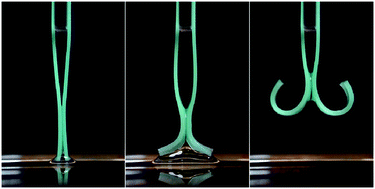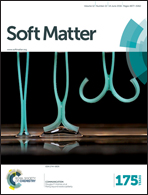Rising beyond elastocapillarity†
Abstract
We consider the elastocapillary rise between swellable structures using a favorable solvent. We characterize the dynamic deformations and resulting equilibrium configurations for various beams. Our analysis reveals the importance of the spacing between the two beams, and the elastocapillary length  ec, which prescribes the relative magnitude of surface tension and bending stiffness in the system. In particular, we rationalize the transition between coalescence-dominated, bending-dominated, and swelling-dominated regimes, and enumerate the subtle interfacial mechanisms at play in the ratcheting of a fluid droplet trapped between the curling beams.
ec, which prescribes the relative magnitude of surface tension and bending stiffness in the system. In particular, we rationalize the transition between coalescence-dominated, bending-dominated, and swelling-dominated regimes, and enumerate the subtle interfacial mechanisms at play in the ratcheting of a fluid droplet trapped between the curling beams.


 Please wait while we load your content...
Please wait while we load your content...